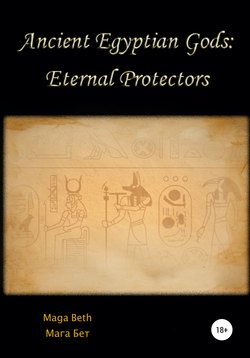Читать книгу Ancient Egyptian Gods: Eternal Protectors - Maribel Pedrera Pérez – Maga Beth - Страница 2
Chapter 1- Introduction: Brief History of Egypt
ОглавлениеThe Egyptian people were a civilization that developed throughout history for more than 3,000 years, c 3150 BC to 31 BC, until its conquest by the Roman Empire. Then, it disappeared as a State.
In Ancient Egypt, gods were basic for people´s beliefs and rituals. There were many gods and pharaohs who were the kings of Egypt. As well as governing, pharaohs were considered and worshipped as gods. Many Egyptian gods are names of pharaohs.
Pharaohs were the union of people with deities. People offered them all kinds of obeisance, prayers, and offerings so that they would be happy and everything would be propitious to them.
Their religion was a complex belief system in which they interacted with several deities who controlled their lives through the elements and forces of nature. The religion lasted for more than 3,000 years and had its roots in Egyptian prehistory.
The Egyptians, as a great state, allocated many resources to build temples and to conduct rituals dedicated to the gods. They believed in their interaction with the gods, they prayed, did magic and rituals asking for everything they needed.
The main deities in the Ancient Egyptian culture followed a family structure difficult to understand when compared with the current family structures.
Most family members were dual, i.e., there could be a female deity or both, but they were always related to a male deity. Affective and sexual relations between parents, siblings and offspring were frequent and normal. Male gods were better considered than female gods.
We must bear in mind that many were the same god, but with different names and different evolution depending on the region of Egypt in which they were worshipped. The main worship centres were in the cities of Tell-el-Amarna, Memphis, Thebes, Hermópolis, Heliopolis, Edfu, Dendera, Karnak, Esna, Aswan, among others.
In my opinion, the god Atum and his four siblings were the basis of this structure: Atum (god of the setting sun), Ra (god of the noon sun, god of light, sun and heaven, the origin of life), Khepri (god of the rising sun) and Khnum (god of the night).
From the family of Ra and his wife Maat (goddess of justice, truth and harmony, who was also Thoth's wife) merged Sekhmet (goddess of war). Sekhmet married Ptah or Apis. Nefertum was the son of Sekhmet and Ptah. In some places of worship Nefertum was equivalent of the solar god Atum.
Atum had many offspring and most of the Egyptian worship came from this family.
It is sometimes said that Atum created himself; others, that his parents were Nun-Nunet (gods of the essential waters). Atum gave life to two offspring: Shu and Tefnut, thus being father and mother at the same time, thus the creator and the giver of life god.
Shu (god of the air) and Tefnut (goddess of moisture) had two offspring: Geb (god of the Earth) and Nut (goddess of the sky).
Geb and Nut had four offspring: Nephthys (goddess of darkness, shadows, and moisture), Set (god of evil and chaos), Isis (goddess of magic and wisdom), and Osiris (god of resurrection, fertility, agriculture, and king of the beyond).
Nephthys was the sister-wife of Set. Since Set could not have children, she cheated on him with Osiris, and they had a boy named Anubis (god of death and the underworld).
Isis was the sister-wife of Osiris and from their great love was born Horus (god of heaven, war and hunting).
Horus married Hathor (goddess of love, joy, dance and music) and they had two children: Ihy (child god of joy and music) and Harsomtus (god of food and creation).
Ra also called Amon-Ra (an almighty god who was everywhere) had two wives: Amonet (goddess of the wind who did not need any man) and Mut (creator goddess). Amon-Ra and Mut gave birth to Khonsu (god of medicine and healer). They also adopted a son named Mantu (god of war).
Ra also had two daughters: Hathor who married Horus and Keket (goddess of darkness) who married Keku (god of darkness). Thus, one may say that Ra had 5 offspring: Hathor, Keket, Khonsu, Mantu and Sekhmet.
Khepri (solar deity of the dawn) had no known offspring. Khnum´s (god of the night) consort was Satis (goddess of war, floods, fertility and love) and their offspring was Anuket (goddess of water) who was Satis´ daughter and sister.
Anubis consorts were Thoth (god of wisdom, time and magic) and Maat (goddess of justice, truth and harmony.) Maat was also Ra's wife.
As you can see, Egyptian gods and goddesses are somewhat difficult to understand. This is how I understand them and is the simplest explanation I can give you.
Over time, people believed more in popular religious traditions and the figure of the pharaoh declined.
Some gods were more worshipped than others: e.g., Ra (the sun god), Amun (the creator god), or Isis (the mother).
Death was very important for Ancient Egyptians. They believed in life after death and when someone died they filled their tombs with grave goods, offerings, food, clothing, jewellery, minerals, etc. so that they did not lack anything and had a good journey to the beyond. They made great offerings to ensure that the soul lasted after death.
The Egyptian people became experts in conserving the body of the dead, embalming it with ointments, oils and aromas, which have also been used by the rest of civilisations over the years.
Ancient Egypt mythology and religion have left us many writings and monuments and have had a great impact on ancient and modern cultures.
